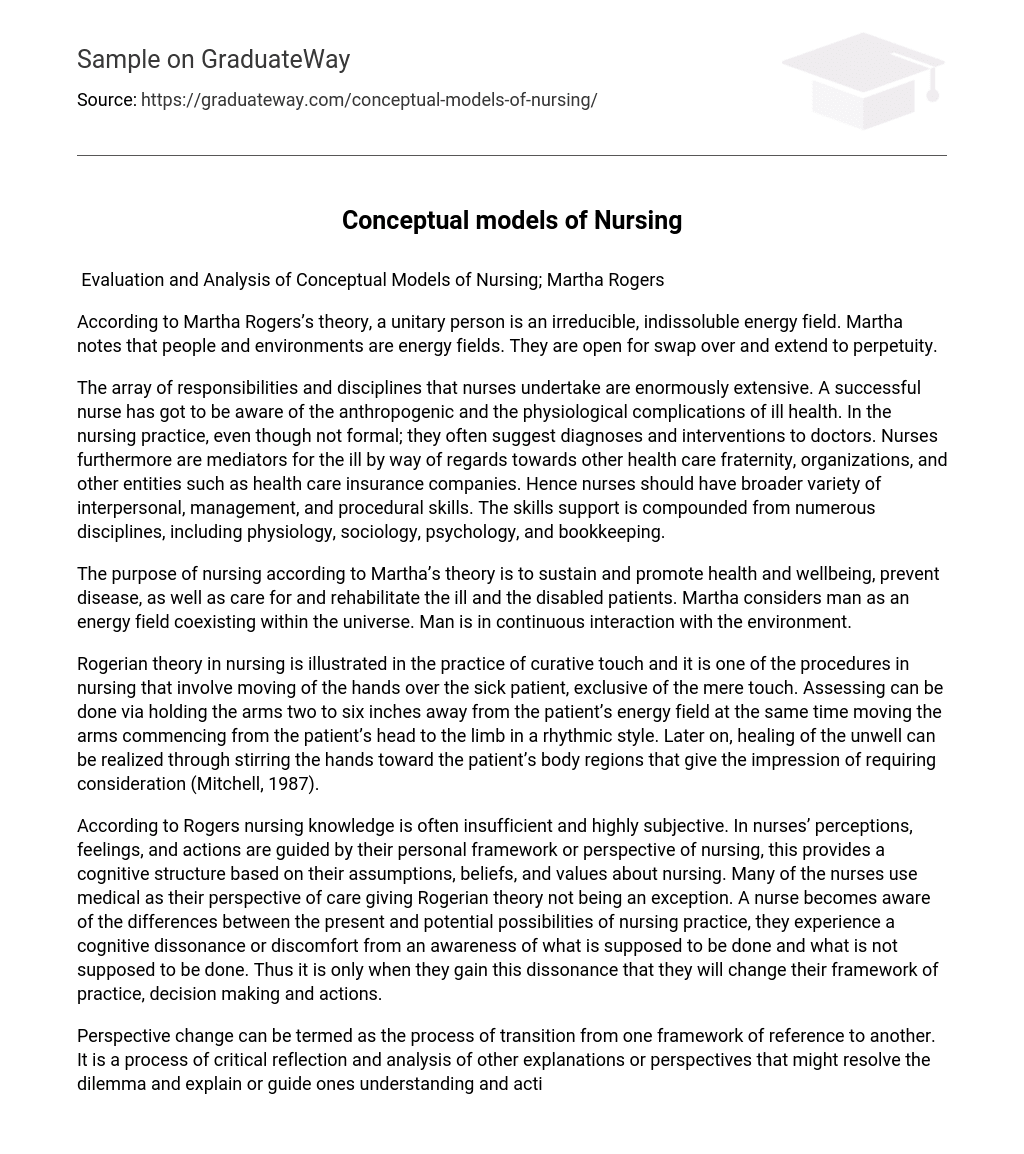Evaluation and Analysis of Conceptual Models of Nursing: Martha Rogers.
According to Martha Rogers’ theory, a unitary person is an irreducible, indissoluble energy field. Martha notes that people and environments are energy fields that are open for exchange and extend perpetually.
The array of responsibilities and disciplines that nurses undertake is enormously extensive. A successful nurse has to be aware of the anthropogenic and physiological complications of ill health. In the nursing practice, even though not formal, they often suggest diagnoses and interventions to doctors. Nurses are furthermore mediators for the ill with regards to other healthcare fraternities, organizations, and other entities such as healthcare insurance companies. Hence, nurses should have a broader variety of interpersonal, management, and procedural skills. The support for these skills is compounded from numerous disciplines, including physiology, sociology, psychology, and bookkeeping.
The purpose of nursing, according to Martha’s theory, is to sustain and promote health and well-being, prevent disease, as well as care for and rehabilitate ill and disabled patients. Martha considers man as an energy field coexisting within the universe, and in continuous interaction with the environment.
Rogerian theory in nursing is illustrated in the practice of curative touch, which is one of the procedures in nursing that involves moving the hands over the sick patient, exclusive of mere touch. Assessment can be done by holding the arms two to six inches away from the patient’s energy field while moving the arms rhythmically from the patient’s head to the limbs. Later on, healing of the unwell can be realized through stirring the hands toward the patient’s body regions that give the impression of requiring consideration (Mitchell, 1987).
According to Rogers, nursing knowledge is often insufficient and highly subjective. Nurses’ perceptions, feelings, and actions are guided by their personal framework or perspective of nursing. This provides a cognitive structure based on their assumptions, beliefs, and values about nursing. Many nurses use a medical perspective for caregiving, with Rogerian theory not being an exception. When a nurse becomes aware of the differences between the present and potential possibilities of nursing practice, they experience cognitive dissonance or discomfort from an awareness of what is supposed to be done and what is not supposed to be done. Thus, it is only when they experience this dissonance that they will change their framework of practice, decision-making, and actions.
Perspective change can be termed as the process of transitioning from one framework of reference to another. It is a process of critical reflection and analysis of other explanations or perspectives that might resolve the dilemma and explain or guide one’s understanding and actions. The process involves gradually acquiring a new perspective that leads to a fundamental change in the way nurses experience, interpret, and understand their work and their relationship with others (Johnson, 1995).
Nursing diagnosis is only useful if we look at it as a concept denoting a phenomenon (Geoffrey, 2000). Rogers’ theory can be useful in guiding nursing observations, reflections, decisions, and actions by answering the following questions: when does the ailment occur, why does it occur, how do you deal with it, how do you prevent it, and what other conditions occur at the same time as the ailment.
Nursing diagnosis is only useful if we look at diagnosis as a concept denoting a phenomenon (Geoffrey, 2000). Rogers’ theory can be useful in guiding nursing observations, reflections, decisions, and actions by answering the following questions: when does the ailment occur, why does it occur, how do you deal with it, how do you prevent it, and what other conditions occur at the same time as the ailment.
Rogers defined the goal and obligation of a nurse as the professional practice that seeks to promote symphonic man and environment, to strengthen the integrity of a person’s human energy field, as well as to direct and redirect energy fields of the human and environmental fields for achievement of optimum fitness potentials (Rogers, 1970).
The purpose of nursing, and what every nurse should think about, is to promote good health and wellbeing of all people, whatever their affiliation, race, or locality. According to Rogers’s theory, a nurse works on mobilizing individuals’ and family resources, heightening his or her integrity, and strengthening the people-to-environment relationship (Barrie, 1990).
Martha’s theory can be related to the needs and activities of daily living. Diagnoses such as human upper respiratory problems, disability of the limbs, psycho-spiritual concerns, alterations in sleep, and alterations in sexuality have been clearly described and defined in relation to a unitary human being (Kim, 1991). The definition enhances the theory’s clarity for nurses, decreases the level of abstraction, and makes it more amenable to testing.
Some caregivers have demonstrated the use of Rogerian theory, for example, in the delivery of care to patients with cardiac-related problems and impaired neurological functions. Others have demonstrated the theory in injury healing and in conceptualizing hyperactive children within the framework of synergism as being merely changes in a person’s pattern of interaction with the environment. Rogers provides the potential for understanding aging and offers more positive evolutionary changes to explain outcomes through her theory.
References.
Barrie (1990) wrote Reflections on Healing: A Central Nursing Construct, published by Cambridge University Press in Cambridge, which can be found on page 321.
Geoffrey (2000). Martha Rogers Nursing Theory: A Brief Overview.” Skeptical Inquirer.
Mitchell, G. (1987). Nursing Diagnosis: Process and Application. New York: McGraw-Hill.
Johnson (1995) analyzed conceptual models of nursing in Philadelphia: FA Tracy.
Kim, M. (1991). Nursing Diagnosis Research: Classification of Nursing Diagnoses. Philadelphia: Lippincott.
Kinney, M. (1991). Operational definitions for defining characteristics. Nursing Diagnosis.
McGregor, D. (1987). The Therapeutic Touch Intervention. New York: Dodd Mead.





